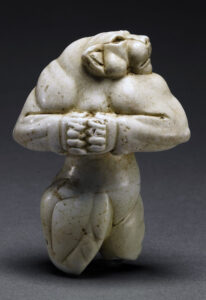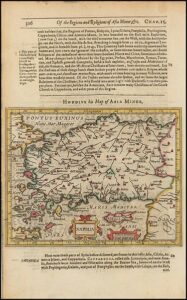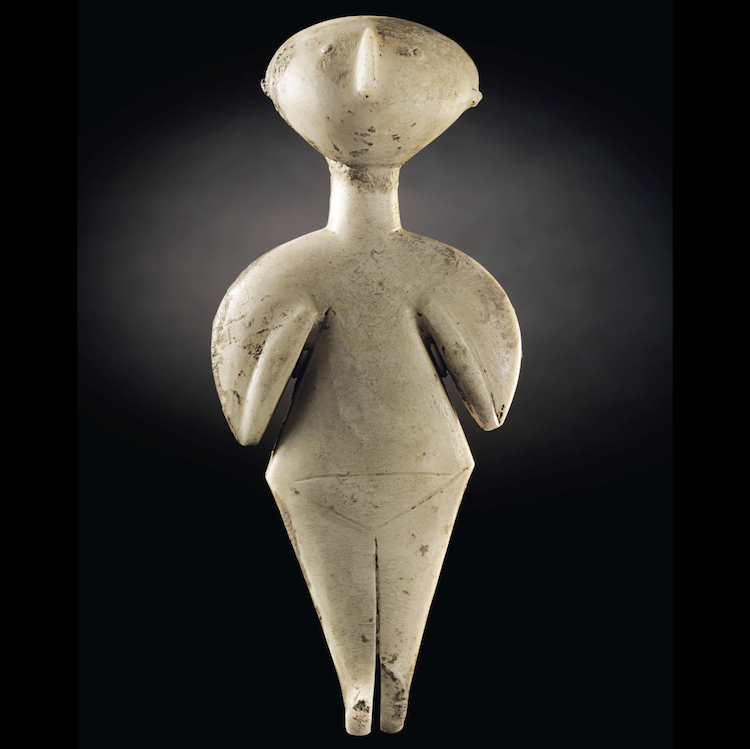“But Turkey sat on its hands despite signals from its own Ministry of Culture that the Stargazer was in New York City…” Republic of Turkey v Christie’s Inc., et al, 2nd U.S. Circuit Court of Appeals No. 21-2485.
Court of Appeals decision gives Stargazer idol back to Christie’s and Steinhardt
On March 8, 2023, the 2nd U.S. Circuit Court of Appeals in Manhattan issued its decision on the Stargazer case, the Republic of Turkey’s appeal from a September 2021 U.S. District Court judgement, holding that Turkey had failed to establish its ownership of a 5,000 year old statue and that the defendants, Christies and Michael Steinhardt, had established an equitable defense against Turkey’s claims that they had intentionally taken Turkey’s property and that it should be seized and returned to Turkey, the true owner (“conversion” and “replevin”).

Near Eastern (Anatolian) Figure of the Kilia Type, 4500–3500 B.C. Marble, 14.3 × 5.4 × 3.6 cm. The J. Paul Getty Museum, Villa Collection, Malibu, CA. The Getty website notes that, “Female figures were made throughout the Aegean basin during the prehistoric period, including in the region of ancient Anatolia (present-day Turkey)… [the] bulbous head, long neck, and flat body are characteristic of the Kilia type of female figurines, named after the village in northwest Turkey where the first examples were found.”
The Court of Appeals decision pointed out that the District Court had been in error in the first part of its decision. The District Court held Turkey would establish ownership if it “prove[d] by a preponderance of the evidence that the Idol was found within and exported from the boundaries of modern-day Turkey after 1906.” The Court of Appeals said that Turkey would only have to make a “threshold showing” of an “arguable claim” of ownership. It is noteworthy that the court explicitly stated that it would not address whether Turkey’s limited evidence met its threshold burden. Judge Lohier, in a brief concurring opinion, stressed that Part 1 of the opinion on the threshold burden and how it would shift to the defendant to prove that the object was not stolen “does not contain any holding.”
However, the Court of Appeals agreed that “Turkey should have been aware of its potential claim in the 1990s. The district court did not improperly add an investigation element to the doctrine of laches.” The court stated:
“Because Turkey had reason to know the Stargazer was its cultural patrimony in the 1990s, it had reason to investigate the artifact and assert its claim to ownership. This is not to say that sovereign nations have a standing obligation to investigate the potential theft of their dispersed artifacts. But Turkey sat on its hands despite signals from its own Ministry of Culture that the Stargazer was in New York City. Turkey’s failure to bring its claim (or even investigate it) until 2017 was unreasonable.”
The known history of the Stargazer
The artifact in the case is known as the “Guennol Stargazer.” It is an Anatolian marble female idol of a type made in Kiliya, in the Anatolian region of Turkey. It is one of the largest and best preserved of the Kiliya-type figurines, at 22.9 cm tall, approximately nine inches, and dates from the Chalcolithic period, approximately 3000 to 2200 BCE.

The Guennol Lioness is a 5,000-year-old Mesopotamian statue depicting an anthropomorphic lioness. 3rd Millennium BCE, photo courtesy Brooklyn Museum of Art.
The Stargazer sought by Turkey was formerly in the Guennol Collection of objects belonging to Alastair Bradley Martin and Edith Park Martin, a collection begun in the late 1940s.[i] The Martins purchased the statue from art dealer John J. Klejman in in 1961 in New York. Klejman died in 1995, Mrs. Martin died in 1989 and Mr. Martin in 2010; thus, no living person is available today to provide information on the statue’s earlier history. The Stargazer was purchased by Michael and Judy Steinhardt in 1993 for $1.5 million.
Christie’s offered the Stargazer for auction in April 2017. It was the highlight of Christie’s Classical Week and featured on the cover of the catalog of Christie’s “The Exceptional Sale.” One day before the sale, the Government of Turkey filed a complaint in federal court seeking to stop the sale and alleging that the statue had been illegally smuggled out of Turkey in the early 1960s in violation of an Ottoman 1909 patrimony law.
On April 28, 2017, Christie’s sold the Stargazer at auction for $14.5 million (including the buyer’s premium), having announced Turkey’s claim prior to the actual auction and giving the buyer the right of cancellation, which the unknown buyer appears to have exercised, never taking possession of the statue.
Preliminary actions
There followed a series of court actions by both sides at the Federal District Court for the Southern District of New York. In 2019, the court rejected the defendants’, Michael Steinhardt’s and Christie’s, motion to dismiss Turkey’s case for conversion and replevin (illegal taking of another’s property and the right to its return); it also rejected the defendants’ claim against Turkey for tortious interference with contract. A key result of the 2019 rulings was that while all parties acknowledged that the statue had been nearly continuously displayed at the Metropolitan Museum for decades, the lengthy public display of an artwork was not sufficient, in itself, to bar its recovery.
The lower court proceeding
U.S. District Judge Alison Nathan held a (no-jury) bench trial in April 2021 on whether the Government of Turkey or Steinardt and Christie’s held title to the Stargazer.

Jodocus Hondius, ‘Natolia’, Anatolia (1625-26 edition of Purchas’ His Pilgrims)
The court found that a 1906 Ottoman decree was an enforceable ownership law if Turkey could show by the preponderance of the evidence that the Stargazer had been in Turkey after 1906. Turkey claimed, for example, that if it had been outside Turkey prior to the 1960s, it would have been noted; the defense countered that similar statues found earlier were not very valuable and did not generate particular interest.
There was evidence presented that established to the court’s satisfaction that the Stargazer had been made in Anatolia some 4-5,000 years before, but there was also evidence that similar statues had traveled far beyond their place of origin in ancient times, as similar statues had been found outside of Turkey in the 19th and 20th centuries. Dr. Neil Brodie, a witness for Turkey, stated that there was not evidence of travel of Kiliya statuettes traded beyond Turkey in the Chalcolithic period. The defense presented evidence by Dr. Maxwell Anderson of trade taking place between present day Turkey and Greece from 5,000 years before the Kiliya statues were made. The District Court concluded, “Taken together, this evidence establishes that the Idols were transported both during the Chalcolithic period and in the 19th and early 20th centuries.” Knowing the place of manufacture did not therefore establish the place of discovery. The court held that Turkey had not met its burden of proof that the statues had been found in Turkey after 1906.
The laches defense
The court also heard arguments from Christie’s and Steinhardt that even if it was shown that the Stargazer had been in Turkey after 1906, that the Turkish government knew where the Stargazer was and that it failed to make a timely claim.
The Stargazer had been prominently displayed at one of the world’s greatest museums for decades; it was loaned by the Martins from 1967 to 1993 and again by the Steinhardts from 1999 to 2007 to New York’s Metropolitan Museum of Art. The museum is 2.4 miles from Turkey’s New York Consulate and Permanent Mission to the United Nations, less than an hour’s walk away.
It was clear from the District Court record that during 1990s, before Steinhardt purchased the Stargazer, Turkey’s cultural ministry should have been aware of published literature about it. Turkey’s cultural ministry itself had published an essay identifying the statue as Anatolian in 1977 – and Steinhardt was known as the Stargazer’s current owner. Despite having both notice and ample opportunity to claim the statute for decades, it had failed to take any action whatsoever to investigate or to claim it.
Turkey claimed that it was “neither aware, nor should it have been aware” of its claim to the artifact until its provenance was published in the Christies catalog.
The District Court found that the defendants had been prejudiced in their ability to vindicate themselves by Turkey’s delay, due to the death of potential witnesses (the Martins and Klejman). If Turkey had made a claim before 1993, Steinhardt might not have bought the statue in the first place. While Turkey attempted to claim that Steinhardt had not done due diligence, the record showed that he had consulted with experts and relied on their opinions and on the museum’s reputation and the statue’s years of published provenance.
Response from Turkey to the Court of Appeals decision
After the decision, Lawrence Kaye, attorney for the Republic of Turkey, said that, “This decision will not deter the Republic of Turkey from continuing to aggressively seek the return of cultural objects that have been stolen from it.”

Plate with a hunting scene from the tale of Bahram Gur and Azadeh, Sasanian, ca. 5th century CE , formerly in the Guennol Collection, loaned to the Metropolitan Museum 1963 until 1994, acquired by the Museum in 1994.
[i] The Martins gifted and loaned numerous objects to major public museums, included the Met and the Brooklyn Museum, which featured their gifts in an exhibition in 2000. The most famous object from the Guennol Collection, since sold, is a 5,000 year old Elamite statue of a lioness that is only 3.25 inches tall.
 An anatolian marble female idol of Kiliya type. Chalcolithic period, c. 3000-2200 BC. 9 in (22.9 cm) high. Courtesy Christie's.
An anatolian marble female idol of Kiliya type. Chalcolithic period, c. 3000-2200 BC. 9 in (22.9 cm) high. Courtesy Christie's. 

